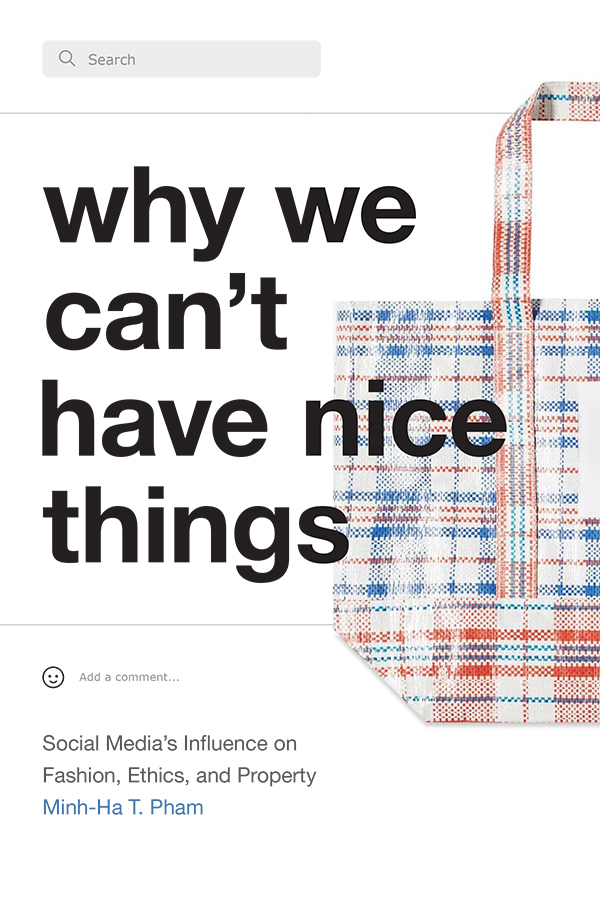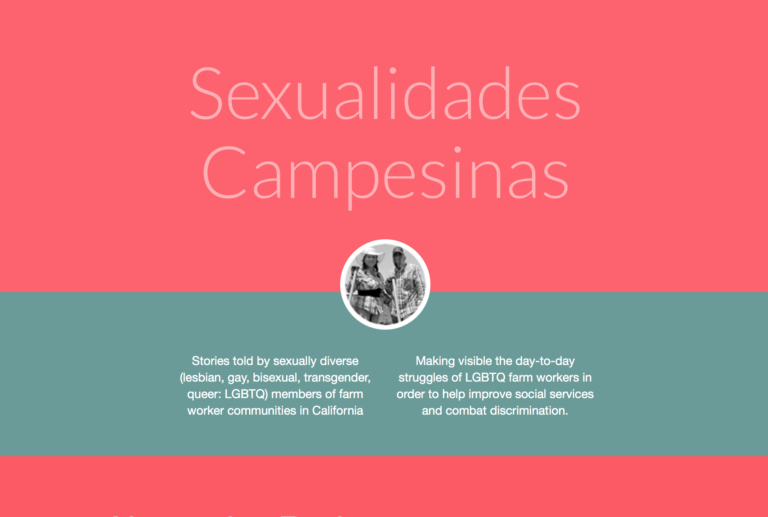This article focuses on the visual materials of the Cremisan Winery Estate’s Facebook page to argue that Cremisan’s digital presence is complex and multivocal, eschewing binaries of digital food activism or consumer-oriented marketing. My approach (using digital and “analog” research) grounds media analysis in site visits and sees digital content as a method of creatively resisting oppressive structures and digital space as locations in which interactions occur. I suggest that Deir Cremisan’s Facebook page participates in a complex discourse between contemporary political debates, piety, local and international commodity markets, and the pragmatics of the daily operations of running a vineyard and winery.
Keyword: digital
Review of Why We Can’t Have Nice Things: Social Media’s Influence on Fashion, Ethics, and Property by Minh-ha T. Pham (Duke University Press)
In her second book, Why We Can’t Have Nice Things: Social Media’s Influence on Fashion, Ethics, and Property, Minh-ha T. Pham continues her examination of fashion’s digital labors, by analyzing what she terms crowdsourced intellectual property (IP) regulation. Pham argues that crowdsourced IP regulation follows a script that reaffirms the racial and class hierarchies that govern global fashion. A process that occurs across social media platforms, crowdsourced IP regulation does not actually adjudicate theft or ownership, but instead marks a site of struggle wherein the right to copy is publicly forged via commonsense, racialized ideas about who or what a “copycat” looks like. Pham explores this process through several case studies, as well as through the history of intellectual property within the fashion industry in the United States. Pham concludes her book with some reflections regarding the possibility of ethical fashion amidst a deeply unethical industry.
Review of The Digitally Disposed: Racial Capitalism and the Informatics of Value by Seb Franklin (University of Minnesota Press)
The Digitally Disposed: Racial Capitalism and the Informatics of Value examines the convergence between the recursive function of value in capitalist economies and the functions of abstraction, ascription, and disposal that govern digital systems. Franklin argues that digitality’s most pernicious effects are apparent in how digital systems create the illusion of frictionlessness, connectivity, and access, while at the same time working to reinforce a logic of exclusion that externalizes the material realities of depletion. Participation in value-mediated social relations has become mandatory due to the global reach and ubiquitous extension of the informational and economic systems under which workers labor. Race and gender are social categories which position marginalized workers, especially workers from the Global South, as unreliable components in the system, the digitally disposed. Franklin argues, using the study of communication systems, that this positioning is not a flaw of the system, but is rather the intentional effect of forms of capitalist accumulation that depend on the precarity of the lives of those who generate the labor that the system depends on. A valuable contribution to the study of digitality, neoliberalism, political economy, racial capitalism, and technological history, this work shows that the social effects of digitality are not new, but rather are an intensification of the exclusions and forms of marginalization upon which capitalism depends.
For the Moment, I Am Not Scrolling
Andrew Culp and Cultural Studies Association’s New Media and Digital Cultures Working Group Co-Chair Claudia Skinner take a look into Adi Kuntzman and Esperanza Miyake’s new book Paradoxes of Digital Disengagement: In Search of the Opt-Out Button, published by University of Westminster Press (2022).
Ethics, Collaboration, and Knowledge Production: Digital Storytelling with Sexually Diverse Farmworkers in California
This article outlines the digital storytelling methods used for a community based research project focused on issues of sexuality among California farmworkers: Sexualidades Campesinas. We note how our process of collaboration in the creation and production of digital stories was shaped by the context and our envisioned storytellers. We then offer a critical analysis of our own unique experience with digital storytelling in this project, focusing on a handful of concepts key to understanding the nature of our collaborative production process: community, affect and collaboration, storytelling, performance, and mediation, with an eye to the problem of ethics.
Introduction: In Search of Digital Feminisms
Edited by Katherine Behar and Silvia Ruzanka, In Search of Digital Feminisms includes five essays and the editors’ introduction that suggests we play with the shift from surfing to searching to what is fast becoming the offer, if not the intrusion, of piles of unrequested information. But In Search of Digital Feminisms is not an exercise in melancholia, longing for better digital days now past or for lost feminist horizons. It is a search, having already arrived at a destination, a before and an after all at once, the lost origin that always points to the work of an originary mediation or modulation, if not digitization. In other words, these are not anti-technology works; these are works seeking rather to find ways to creativity and multiplicity in identity and practice that can be an intervention into the contemporary scenes of feminisms and the digital. Although primarily offered as texts, the works that follow point to the need to make theoretical interventions a matter of practices, a matter of interactive mediation, a doing, if not a doing with others.
Ungoogleable: In Search of Digital Feminisms
We begin our search for digital feminisms with the following terms: an acknowledgment that “search” represents an ambition which must fail. Siri’s failed searches only scratch at the surface that Siri is.
“Up for Grabs”: Agency, Praxis, and the Politics of Early Digital Art
In its infancy, digital art was, as artist and writer Anne M. Spalter enthusiastically put it, “up for grabs.” But how did women artists overcome the fallacy that computer technology was inherently masculine? And why did computing become a kind of sanctuary for some women artists? I will show that the indeterminacy and flux that permitted freer agency, was reflected in the computing field as a whole. Over time, anti-computer sentiment, which affected all artists using the medium, would prove so pervasive that it often eclipsed the sexism later suffered by women.
In Search of Digital Feminisms: Digital Gender & Aesthetic Technology
What is it that influences girls’ choices of new technology? How is digital creativity affected by gender norms? “Digital Gender & Aesthetic Technology” aims to make visible females as creative developers of the Internet and new technology, through interviews with students, artists, project managers, and entrepreneurs. The prevailing social norms appear to be reflected on the Internet as “digital gender norms,” where girls and boys prefer apparently different communication tools. While working with the question of “digital gender,” I have developed the hypothesis of “Aesthetic Technology,” namely that girls often have an artistic approach towards technology. Girls mainly learn technology for a personal reason, planning to create something once they have learned the technique, and their goal often have aesthetic preferences. The question of girls “becoming technical,” is more complicated than one might first think, in relation to gender. Even though young girls are often just as interested in technology as young boys are, it is difficult for them to keep or adapt their technical interest to normative femininity in their teens. Another problem is that expressions of technical competence or innovation, which do not correspond to the predominant male norm, might be hard to recognize. Females who study within the field of creative digital technology often begin their career by struggling with questions of equality, instead of just practicing their profession.
In Search of a www.analogfeminism.net: Starting with Three Contrarian Concepts via Mother-Daughter Machines to Come
Analog feminism (AF) and digital feminism (DF) are two sides of the same coin; or, multiple twin sisters joined at the hip. Skating from René Descartes to Kara Walker, she asks us “to go gray between zeroes and ones.” Reverting from the digital to its ancestral digit, a finger, Lee uses text and textuality to point out a multiplicity of directions, all of which refrain from a directive. In a series of “posts” negotiating, inheritance, reference, and influence, the daughter searching for the mother returns to sender. Whatever the case, we, or at least one of us, are here to focus on and fly with what’s left uncoordinated in—and connecting—all that’s (to be) digit-alled in the evolving idioms of feminist discourses.






